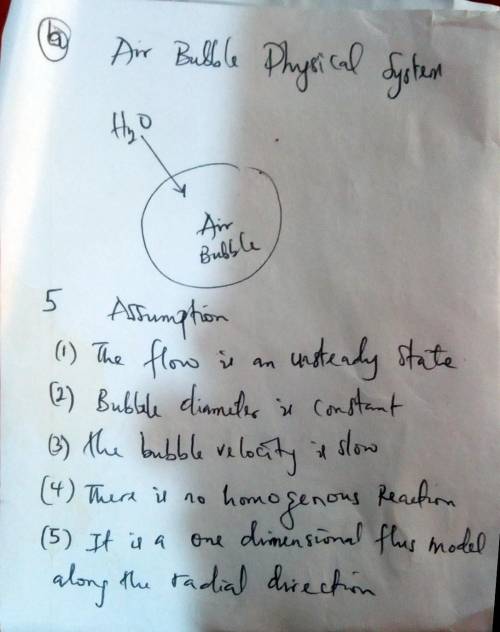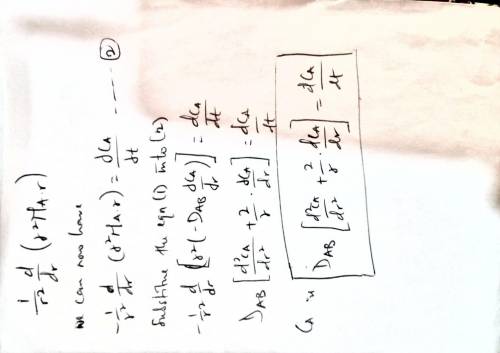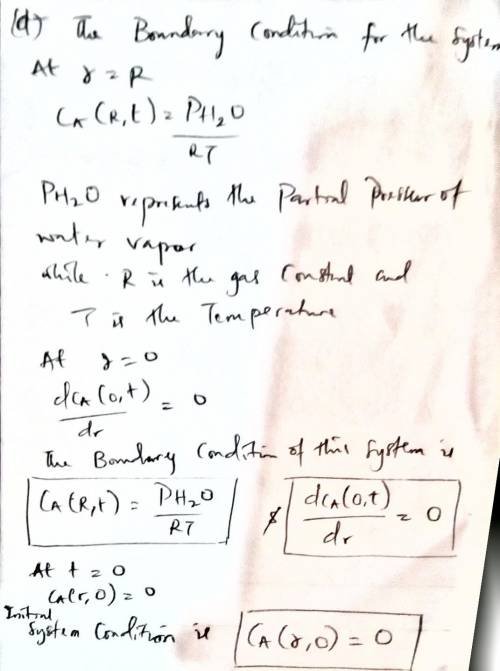
Engineering, 19.05.2020 20:13 nhester3378
A common process for increasing the moisture content of air is to bubble it through a column of water. The air bubbles are assumed to be spheres having an initial radius of 1.0 mm, and are in thermal equilibrium with the surrounding water. The saturation or equilibrium vapor pressure of water is temperature dependent, ranging from about 0.03 atm at 298 K to 1.0 atm at 373 K. The total pressure of the gas inside the air bubble is 1.0 atm, and will not change even as water evaporates into it. The bubbles initially contain some water vapor (along with the other components of air).
a. How will the final bubble radius vary i) with initial water vapor concentration in the bubble and ii) with bubble/water temperature?
b. Draw a picture of the physical system, and state at least five reasonable assumptions for the mass-transfer aspect of the water evaporation process. What coordinate system should be used?
c. What are the simplified differential forms of Fick's flux equation for water vapor (species A), the general differential equation for mass transfer in terms of concentration CA, and a resulting expression that combines the two (don't worry if it can't be too simplified).
d. Propose reasonable boundary and initial conditions

Answers: 3


Another question on Engineering

Engineering, 04.07.2019 19:10
Asteel wire of 2 mm diameter is fixed between two points located 2 m apart. the tensile force in the wire is 250n, if its density of steel is given by 7830 kg/m3 the fundamental frequency of vibration hz? ?
Answers: 3

Engineering, 04.07.2019 19:20
The process in which the system pressure remain constant is called a)-isobaric b)-isochoric c)-isolated d)-isothermal
Answers: 3

Engineering, 04.07.2019 19:20
To save energy, the air supply to a 2000 ft office has been shut off overnight and the room temperature has dropped to 40°f. in the morning, the thermostat is reset to 70°f and warm air at 120 f begins to flov in at 200ft'/min. the air is well mixed within the room, and an equal mass flow of air at room temperature (changing with time) is withdrawn through a return duct. the air pressure is nearly 1 atm everywhere. ignoring heat transfer with the surroundings and kinetic and potential energy effects, estimate how long it takes for the room temperature to reach 70°f. plot the room temperature as a function of time.
Answers: 1

Engineering, 04.07.2019 19:20
Acompressor compresses a gas, a pump compresses a liquid. for a given pressure ratio, why does it take more work to compress a gas in a compressor than a liquid in a pump? a)- for a given pressure ratio the average specific volume for a gas is much higher than the average specific volume for a liquid. b)- there is no difference. the only difference is the amount of heat generated (not work) c)- for a given pressure ratio the average volurge for a gas is much higher than the average volume for a liquid. d)-there is no difference
Answers: 3
You know the right answer?
A common process for increasing the moisture content of air is to bubble it through a column of wate...
Questions




Mathematics, 22.03.2021 19:10

English, 22.03.2021 19:10

Mathematics, 22.03.2021 19:10

Geography, 22.03.2021 19:10

Business, 22.03.2021 19:10

Geography, 22.03.2021 19:10

Mathematics, 22.03.2021 19:10

English, 22.03.2021 19:10



Mathematics, 22.03.2021 19:10


Biology, 22.03.2021 19:10

Mathematics, 22.03.2021 19:10

Mathematics, 22.03.2021 19:10

Mathematics, 22.03.2021 19:10

Business, 22.03.2021 19:10







